INSPECT NO. 1 TRANSFER GEAR SHIFT FORK AND FRONT DRIVE CLUTCH SLEEVE
INSPECT NO. 2 TRANSFER GEAR SHIFT FORK AND HIGH AND LOW CLUTCH SLEEVE
INSPECT TRANSFER SHIFT ACTUATOR ASSEMBLY (HIGH-LOW TRANSFER SHIFT ACTUATOR)
INSPECT TRANSFER SHIFT ACTUATOR ASSEMBLY (CENTER DIFFERENTIAL LOCK ACTUATOR)
INSPECT TRANSFER SHIFT ACTUATOR ASSEMBLY (TEMPERATURE SENSOR) (w/ Temperature Sensor)
Transfer Assembly -- Inspection |
| 1. INSPECT TRANSFER INPUT SHAFT |
Using a micrometer, measure the diameter of the input shaft journal surface.
- Minimum diameter:
- 68 mm (2.68 in.)
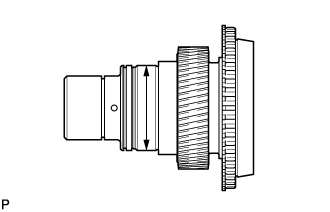 |
Using a dial indicator, measure the inside diameter of the input shaft bush.
- Maximum inside diameter:
- 46 mm (1.81 in.)
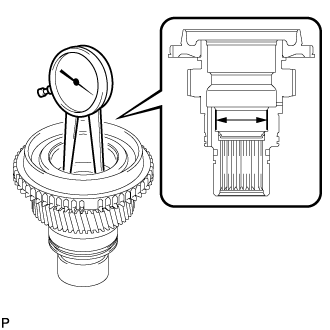 |
| 2. INSPECT TRANSFER LOW PLANETARY GEAR ASSEMBLY |
Using a feeler gauge, measure the thrust clearance of the pinion gear.
- Standard clearance:
- 0.11 to 0.85 mm (0.00434 to 0.0334 in.)
- Maximum clearance:
- 0.85 mm (0.0334 in.)
 |
Using a dial indicator, measure the radial clearance of the pinion gear.
- Standard clearance:
- 0.01 to 0.04 mm (0.000394 to 0.00157 in.)
- Maximum clearance:
- 0.04 mm (0.00157 in.)
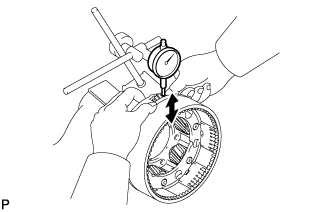 |
| 3. INSPECT REAR TRANSFER OUTPUT SHAFT |
Using a micrometer, measure the diameter of the output shaft journals.
- Minimum Diameter:
Journal Specified Condition A 38 mm (1.50 in.) B 42 mm (1.65 in.) C 49 mm (1.93 in.)
 |
| 4. INSPECT NO. 1 TRANSFER GEAR SHIFT FORK AND FRONT DRIVE CLUTCH SLEEVE |
Using a feeler gauge, measure the clearance between the clutch sleeve and gear shift fork.
- Maximum clearance:
- 0.8 mm (0.0315 in.)
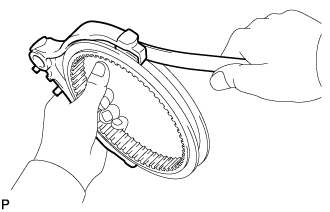 |
| 5. INSPECT NO. 2 TRANSFER GEAR SHIFT FORK AND HIGH AND LOW CLUTCH SLEEVE |
Using a feeler gauge, measure the clearance between the clutch sleeve and gear shift fork.
- Maximum clearance:
- 3.15 mm (0.124 in.)
 |
| 6. INSPECT NO. 1 SYNCHRONIZER RING (for Manual Transmission) |
Apply gear oil to the cone of the input shaft, and check that it does not turn in both directions while pushing the No. 1 synchronizer ring.
If it can turn, replace the No. 1 synchronizer ring.
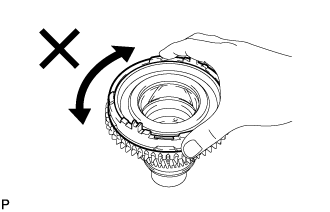 |
Push the No. 1 synchronizer ring to the cone of the input shaft. Measure the clearance between the No. 1 synchronizer ring and input shaft.
- Standard clearance:
- 0.86 to 1.54 mm (0.0339 to 0.0606 in.)
- Minimum clearance:
- 0.86 mm (0.0339 in.)
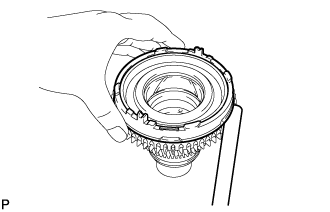 |
| 7. INSPECT TRANSFER SHIFT ACTUATOR ASSEMBLY (HIGH-LOW TRANSFER SHIFT ACTUATOR) |
Check the high-low transfer shift actuator.
Check the high to low switch.
- Connect lines via a relay as shown in the illustration, and check that the actuator fork moves from the high to low position.
- NOTICE:
- Make sure to perform this inspection with the actuator removed from the vehicle. If this inspection is performed with the actuator installed to the vehicle, the actuator will be damaged.
- When inspecting the actuator, make sure to operate it with the lines connected via a relay. If the lines are not connected via a relay and battery voltage is directly applied to the actuator, the actuator will be damaged.
- HINT:
- When performing the operation described above, use the DEFOG relay.

- After the high to low switch is complete, check the neutral position detection switch and limit switch.
- Measure the resistance according to the value(s) in the table below.
- Standard Resistance:
Tester Connection Condition Specified Condition 3 (N)* - 7 (GND) After high to low switch is complete 10 kΩ or higher 4 (HL1) - 7 (GND) After high to low switch is complete 10 kΩ or higher 5 (HL3) - 7 (GND) After high to low switch is complete 10 kΩ or higher 6 (HL2) - 7 (GND) After high to low switch is complete Below 1 Ω
If there is a malfunction, replace the transfer shift actuator assembly.
- Connect lines via a relay as shown in the illustration, and check that the actuator fork moves from the high to low position.
Check the low to high switch.
- Connect lines via a relay as shown in the illustration, and check that the actuator fork moves from the low to high position.
- NOTICE:
- Make sure to perform this inspection with the actuator removed from the vehicle. If this inspection is performed with the actuator installed to the vehicle, the actuator will be damaged.
- When inspecting the actuator, make sure to operate it with the lines connected via a relay. If the lines are not connected via a relay and battery voltage is directly applied to the actuator, the actuator will be damaged.
- HINT:
- When performing the operation described above, use the DEFOG relay.

- After the low to high switch is complete, check the neutral position detection switch and limit switch.
- Measure the resistance according to the value(s) in the table below.
- Standard Resistance:
Tester Connection Condition Specified Condition 3 (N)* - 7 (GND) After low to high switch is complete 10 kΩ or higher 4 (HL1) - 7 (GND) After low to high switch is complete Below 1 Ω 5 (HL3) - 7 (GND) After low to high switch is complete 10 kΩ or higher 6 (HL2) - 7 (GND) After low to high switch is complete 10 kΩ or higher
If there is a malfunction, replace the transfer shift actuator assembly.
- Connect lines via a relay as shown in the illustration, and check that the actuator fork moves from the low to high position.
| 8. INSPECT TRANSFER SHIFT ACTUATOR ASSEMBLY (CENTER DIFFERENTIAL LOCK ACTUATOR) |
Check the center differential lock actuator.
Check the free to lock switch.
- Connect lines via a relay as shown in the illustration, and check that the actuator fork moves from the free to lock position.
- NOTICE:
- Make sure to perform this inspection with the actuator removed from the vehicle. If this inspection is performed with the actuator installed to the vehicle, the actuator will be damaged.
- When inspecting the actuator, make sure to operate it with the lines connected via a relay. If the lines are not connected via a relay and battery voltage is directly applied to the actuator, the actuator will be damaged.
- HINT:
- When performing the operation described above, use the DEFOG relay.
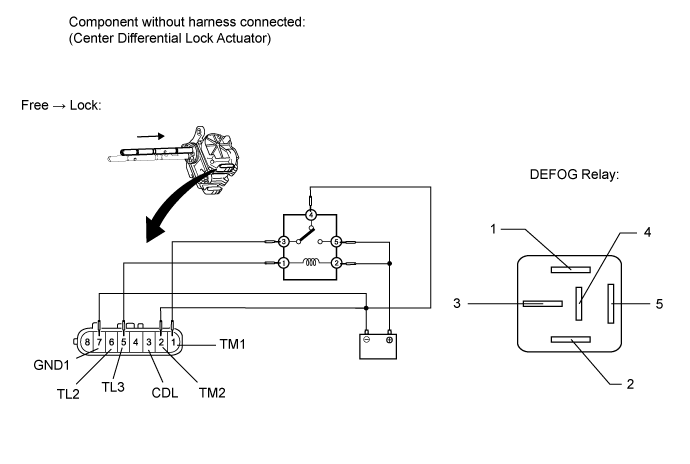
- After the free to lock switch is complete, check the center differential lock detection switch and limit switch.
- Measure the resistance according to the value(s) in the table below.
- Standard Resistance:
Tester Connection Condition Specified Condition 3 (CDL) - 7 (GND1) After free to lock switch is complete Below 1 Ω 5 (TL3) - 7 (GND1) After free to lock switch is complete 10 kΩ or higher 6 (TL2) - 7 (GND1) After free to lock switch is complete Below 1 Ω
- Connect lines via a relay as shown in the illustration, and check that the actuator fork moves from the free to lock position.
Check the lock to free switch.
- Connect lines via a relay as shown in the illustration, and check that the actuator fork moves from the lock to free position.
- NOTICE:
- Make sure to perform this inspection with the actuator removed from the vehicle. If this inspection is performed with the actuator installed to the vehicle, the actuator will be damaged.
- When inspecting the actuator, make sure to operate it with the lines connected via a relay. If the lines are not connected via a relay and battery voltage is directly applied to the actuator, the actuator will be damaged.
- HINT:
- When performing the operation described above, use the DEFOG relay.
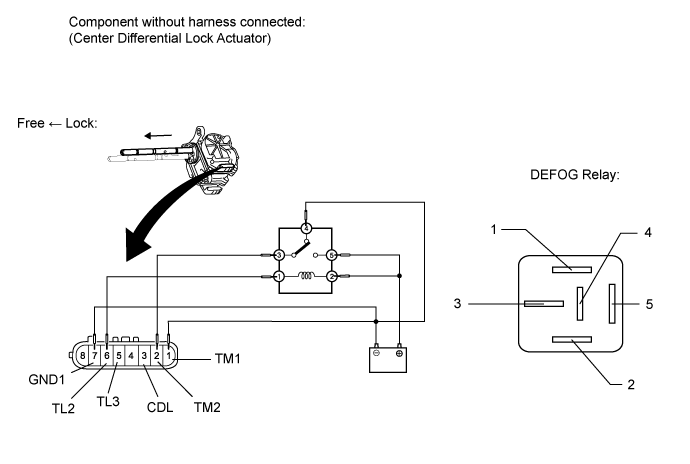
- After the lock to free switch is complete, check the center differential lock detection switch and limit switch.
- Measure the resistance according to the value(s) in the table below.
- Standard Resistance:
Tester Connection Condition Specified Condition 3 (CDL) - 7 (GND1) After lock to free switch is complete 10 kΩ or higher 5 (TL3) - 7 (GND1) After lock to free switch is complete Below 1 Ω 6 (TL2) - 7 (GND1) After lock to free switch is complete 10 kΩ or higher
- Connect lines via a relay as shown in the illustration, and check that the actuator fork moves from the lock to free position.
| 9. INSPECT TRANSFER SHIFT ACTUATOR ASSEMBLY (TEMPERATURE SENSOR) (w/ Temperature Sensor) |
Measure the resistance according to the value(s) in the table below.
- Standard Resistance:
Tester Connection Condition Specified Condition 1 (TT) - Body ground Always 10 kΩ or higher 2 (TGND) - Body ground Always 10 kΩ or higher
Text in Illustration *a Component without harness connected
(Temperature Sensor)
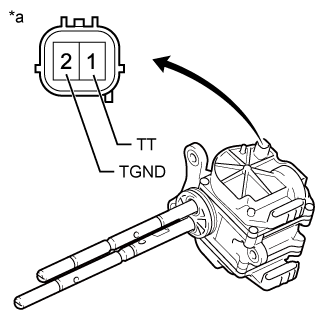 |
While warming the transfer shift actuator assembly, measure the resistance according to the value(s) in the table below.
- Standard Resistance :
Tester Connection Temperature Specified Condition 1 (TT) - 2 (TGND) 10°C (50°F) 3.61 kΩ 20°C (68°F) 2.38 kΩ 30°C (86°F) 1.61 kΩ